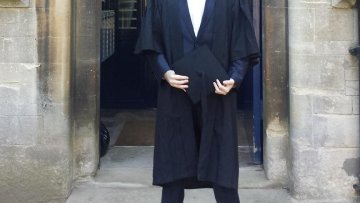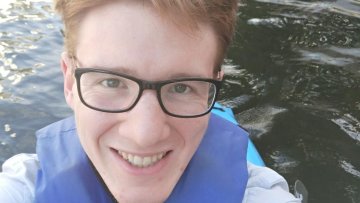Three Oxford Mathematicians, Kristian Kiradjiev, Liam Brown and Tom Crawford are to present their research in Parliament at this year’s STEM for Britain competition at the House of Commons on 13th March. This prestigious competition provides an opportunity for researchers to communicate their research to parliamentarians.
Personalised predictive modelling for transcatheter mitral valve replacement
Abstract
Mitral regurgitation is one of the most common valve diseases in the UK and contributes to 50% of the transcatheter mitral valve replacement (TMVR) procedures with bioprosthetic valves. TMVR is generally performed in frailer, older patients unlikely to tolerate open-heart surgery or further interventions. One of the side effects of implanting a bioprosthetic valve is a condition known as left ventricular outflow obstruction, whereby the implanted device can partially obstruct the outflow of blood from the left ventricle causing high flow resistance. The ventricle has then to pump more vigorously to provide adequate blood supply to the circulatory system and becomes hypertrophic. This ultimately results in poor contractility and heart failure.
We developed personalised image-based models to characterise the complex relationship between anatomy, blood flow, and ventricular function both before and after TMVR. The model prediction provides key information to match individual patient and device size, such as postoperative changes in intraventricular pressure gradients and blood residence time. Our pilot data from a cohort of 7 TMVR patients identified a correlation between the degree of outflow obstruction and the deterioration of ventricular function: when approximately one third of the outflow was obstructed as a result of the device implantation, significant increases in the flow resistance and the average time spent by the blood inside the ventricle were observed, which are in turn associated with hypertrophic ventricular remodelling and blood stagnation, respectively. Currently, preprocedural planning for TMVR relies largely on anecdotal experience and standard anatomical evaluations. The haemodynamic knowledge derived from the models has the potential to enhance significantly pre procedural planning and, in the long term, help develop a personalised risk scoring system specifically designed for TMVR patients.
Reactions, diffusion and volume exclusion in a heterogeneous system of interacting particles
Abstract
Cellular migration can be affected by short-range interactions between cells such as volume exclusion, long-range forces such as chemotaxis, or reactions such as phenotypic switching. In this talk I will discuss how to incorporate these processes into a discrete or continuum modelling frameworks. In particular, we consider a system with two types of diffusing hard spheres that can react (switch type) upon colliding. We use the method of matched asymptotic expansions to obtain a systematic model reduction, consisting of a nonlinear reaction-diffusion system of equations. Finally, we demonstrate how this approach can be used to study the effects of excluded volume on cellular chemotaxis. This is joint work with Dan Wilson and Helen Byrne.
Mechanobiology of cell migration: mathematical modelling and microfluidics-based experiments go hand-in-hand
Abstract
Mechanobiology is a field of science that aims to understand how mechanics regulate biology. It focuses on how mechanical forces and alterations in mechanical properties of cell or tissues regulate biological processes in development, physiology and disease. In fact, all these processes occur in our body, which presents a clear structural and hierarchical organization that goes from the organism to the cellular level. To advance in the understanding of all these processes at different scales requires the use of simplified representations of our body, which is normally known as modelling or equivalently the creation of a model. Different types of models can be found in the literature: in-vitro, in-vivo and in-silico models.
Here, I will present our modelling strategy in which we integrate different mathematical models and experiments in order to tackle relevant mechanical-based mechanisms in wound healing and cancer metastasis progression [1,2]. In fact, we have focused our research on individual [3] and collective cell migration [4], because it is a crucial event in all these mechanisms. Therefore, unravelling the intrinsic mechanisms that cells use to define their migration is an essential element for advancing the development of new technologies in regenerative medicine and cancer.
Due to the complexity of all these mechanisms, mathematical modelling is a relevant tool for providing deeper insight and quantitative predictions of the mechanical interplay between cells and extracellular matrix during cell migration. To assess the predictive capacity of these models, we will compare our numerical results with microfluidic-based experiments [2], which provide experimental information to test and refine the main assumptions of our models.
Actually, we design and fabricate multi-channel 3D microfluidics cell culture chips, which allow recreating the physiology and disease of one organ or any biological process with a precise control of the micro environmental factors [5]. Therefore, this kind of organ-on-a-chip experiments constitutes a novel modelling strategy of in vitro multicellular human systems that in combination with mathematical simulations provide a relevant tool for research in mechanobiology.
References
Escribano J, Chen M, Moeendarbary E, Cao X, Shenoy V, Garcia-Aznar JM, Kamm RD, Spill F. Balance of Mechanical Forces Drives Endothelial Gap Formation and May Facilitate Cancer and Immune-Cell Extravasation. PLOS Computational Biology, in press.
Algorithmic generation of physiologically realistic patterns of fibrosis in the heart
Abstract
Cardiac fibrosis plays a significant role in the disruption of healthy electrical signalling in the heart, creating structural heterogeneities that induce and stabilise arrhythmia. However, a proper understanding of the consequences of cardiac fibrosis must take into account the complex and highly variable patterns of its spatial localisation in the heart, which significantly affects the extent and manner of its impacts on cardiac wave propagation. In this work we present a methodology for the algorithmic generation of fibrotic patterns via Perlin noise, a technique for computationally efficient generation of textures in computer graphics.
Our approach works directly from image data to create populations of pattern realisations that all resemble the target image under a set of metrics. Our technique thus serves as a type of data enrichment, enabling analysis of how variability in the precise placement of fibrotic structures modulates their electrophysiological impact. We demonstrate our method, and the types of analysis it can enable, using a widely referenced histological image of four different types of microfibrotic structure. Our generator and Bayesian tuning method prove flexible enough to successfully capture each of these very distinct patterns.
We demonstrate the importance of this tool, by presenting 2D simulations overlayed on the generated images that highlight the effects of microscopic variability on the electrophysiological impact of fibrosis. Finally, we discuss the application of our methodology to the increasingly available imaging data of fibrotic patterning on a more macroscopic scale, and indeed to other areas of science underpinned by image based modelling and simulation.
00:00
PLEASE NOTE THAT THIS SEMINAR IS CANCELLED DUE TO UNFORESEEN CIRCUMSTANCES
Abstract
PLEASE NOTE THAT THIS SEMINAR IS CANCELLED DUE TO UNFORESEEN CIRCUMSTANCES.
Combining computational modelling, structural biology and immunology to understand Antigen processing
Abstract
Competition between peptides for binding and presentation by MHC class I molecules decides the immune response to foreign or tumor antigens. Many previous studies have attempted to classify the immunogenicity of a peptide using machine learning algorithms to predict the affinity, or half-life, of the peptide binding to MHC. However immunopeptidome analyses have shown a poor correlation between sequence based predictions and the abundance on the cell surface of the experimentally identified peptides. Such metrics are, for instance, only comparable when the abundance of competing peptides can be accurately quantified. We have developed a model for predicting the relative presentation of competing peptides that takes into account off-rate, source protein abundance and turnover and cofactor-assisted MHC assembly with peptides. This model is mechanism based so that it can accommodate complex biology phenomena such as inflammation, up or downregulation of peptide loading complex chaperones, appearance of a mutanome. We have used aspects of the model to drive an investigation of the precise molecular mechanism of peptide selection by MHC I and its associated intracellular cofactors.
00:00
None
Abstract
PLEASE NOTE THAT THIS SEMINAR IS CANCELLED DUE TO UNFORSEEN CIRCUMSTANCES.
Biomechanics can provide a new perspective on microbiology
Abstract
Despite their tiny size, microorganisms play a huge role in many biological, medical, and engineering phenomena. For example, massive plankton blooms are an integral part of the oceanic ecosystem. Algal cells incorporate carbon dioxide, which affects global warming. In industry, microorganisms are used in bioreactors to produce food and medicines and to treat sewage. The human body hosts hundreds of microorganism species, and the number of microorganisms in the human body is roughly double the number of cells in the body. In the intestine, approximately 1 kg of enterobacteria form a unique ecosystem, called the gut flora, which plays important roles in digestion and in relation to infection. Because of the considerable influence that microorganisms have on human life, the study of their behavior and function is important.
Recent research has demonstrated the importance of biomechanics in understanding the behavior and functions of microorganisms. For example, red tides can be induced by the interplay between the background flow and swimming cells. A dense suspension of bacteria can generate a coherent structure, which strongly enhances mass transport in a suspension. These phenomena show that the physical environments around cells alter their behavior and biological functions. Such a biomechanical understanding is still lacking in microbiology, and we believe that biomechanics can provide new perspectives on future microbiology.
In this talk, we first introduce some of our studies of the behavior of individual swimming microorganisms near surfaces. We show that hydrodynamic forces can trap cells at liquid–air or liquid–solid interfaces. We then introduce interactions between a pair of swimming microorganisms, because a two-body interaction is the simplest many-body interaction. We show that our mathematical models can describe the interactions between two nearby swimming microorganisms. Collective motions formed by a group of swimming microorganisms are also introduced. We show that some collective motions of microorganisms, such as coherent structures of bacterial suspensions, can be understood in terms of fluid mechanics. We then discuss how cellular-level phenomena can change the rheological and diffusion properties of a suspension. The macroscopic properties of a suspension are strongly affected by mesoscale flow structures, which in turn are strongly affected by the interactions between cells. Hence, a bottom-up strategy, i.e., from a cellular level to a continuum suspension level, represents a natural approach to the study of a suspension of swimming microorganisms. Finally, we discuss whether our understanding of biological functions can be strengthened by the application of biomechanics, and how we can contribute to the future of microbiology.




